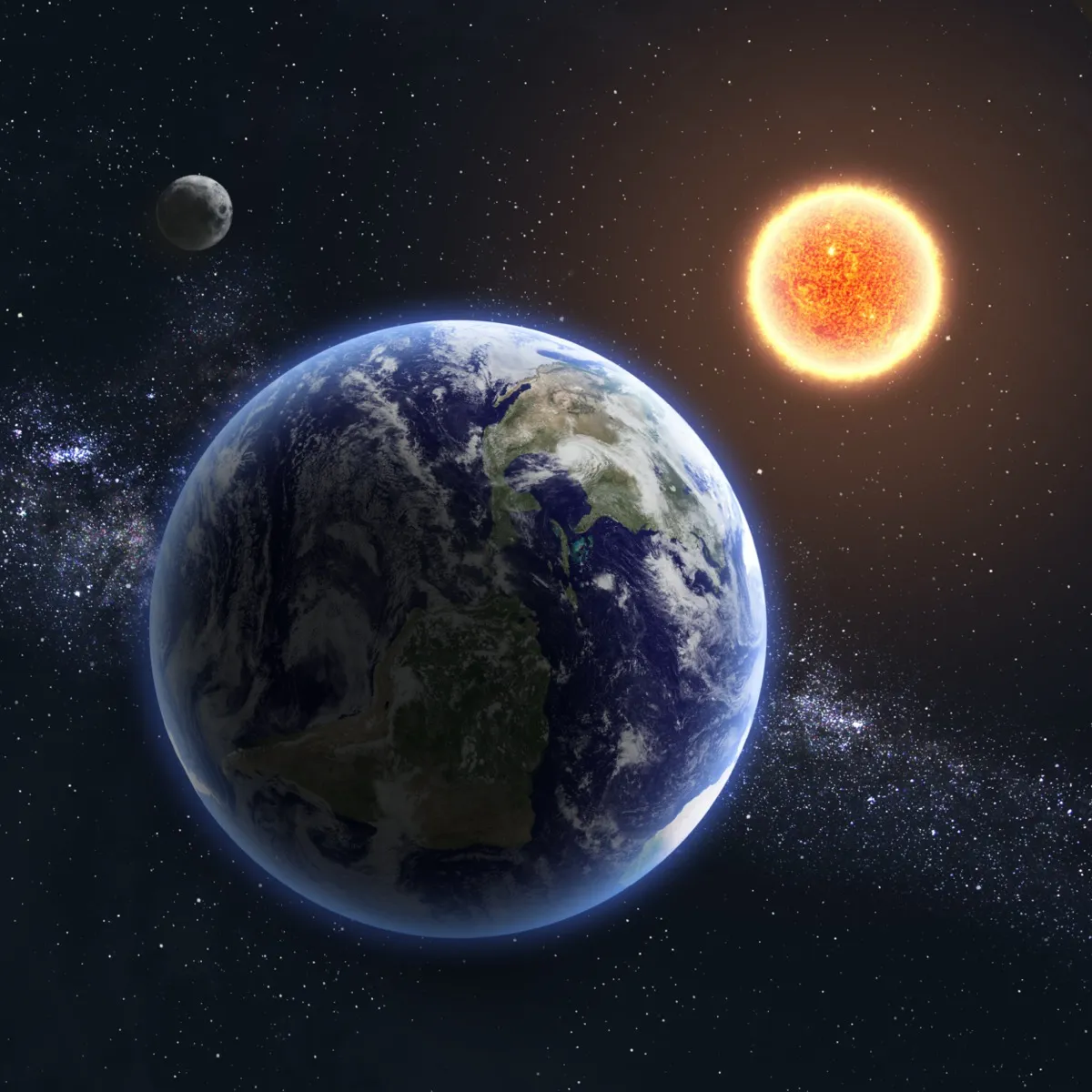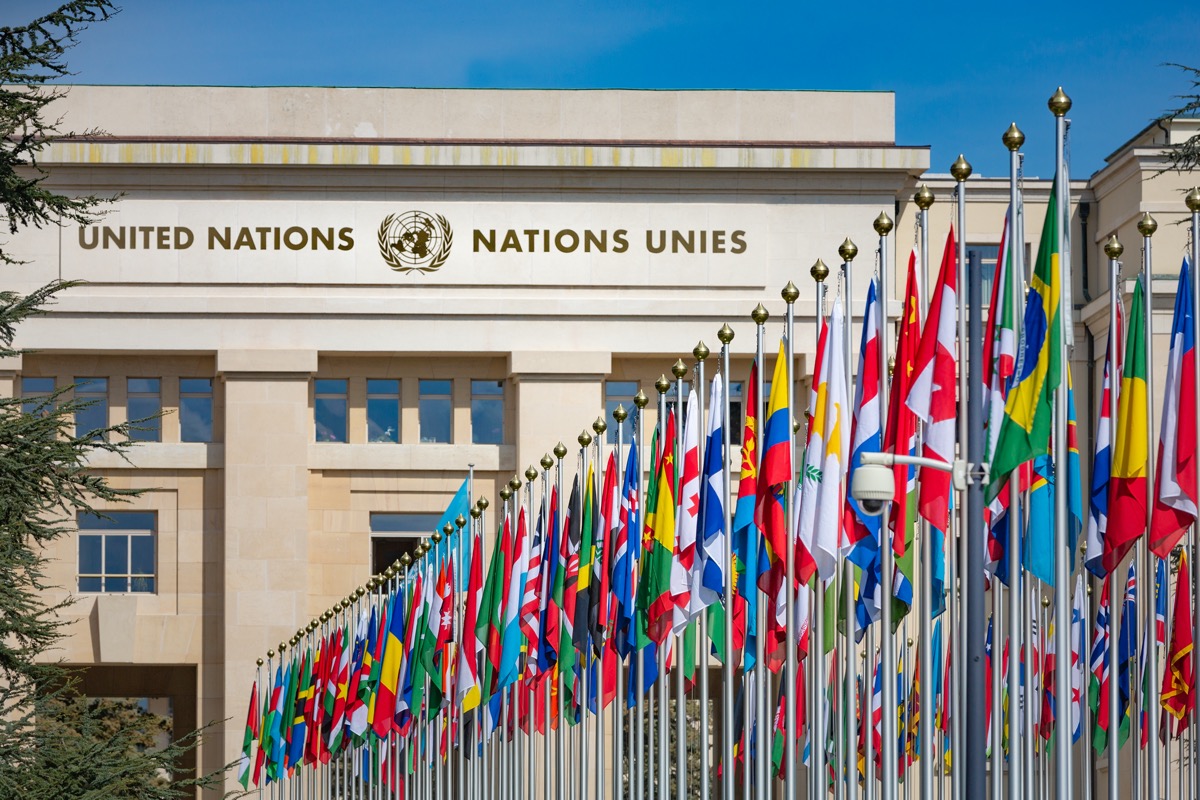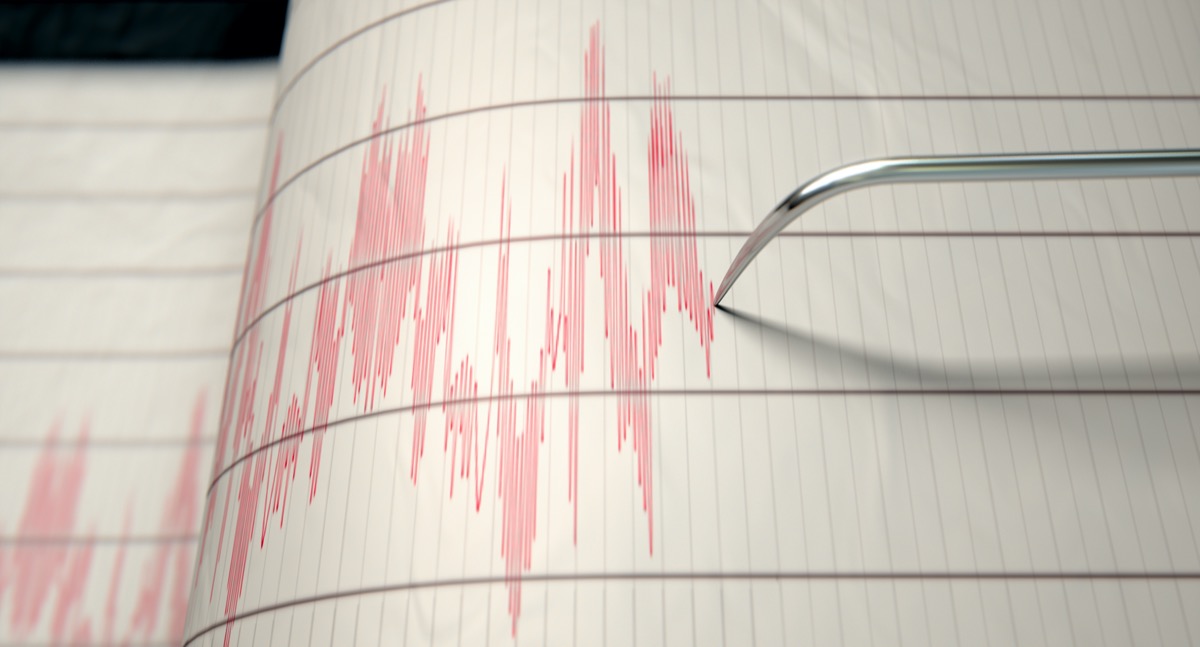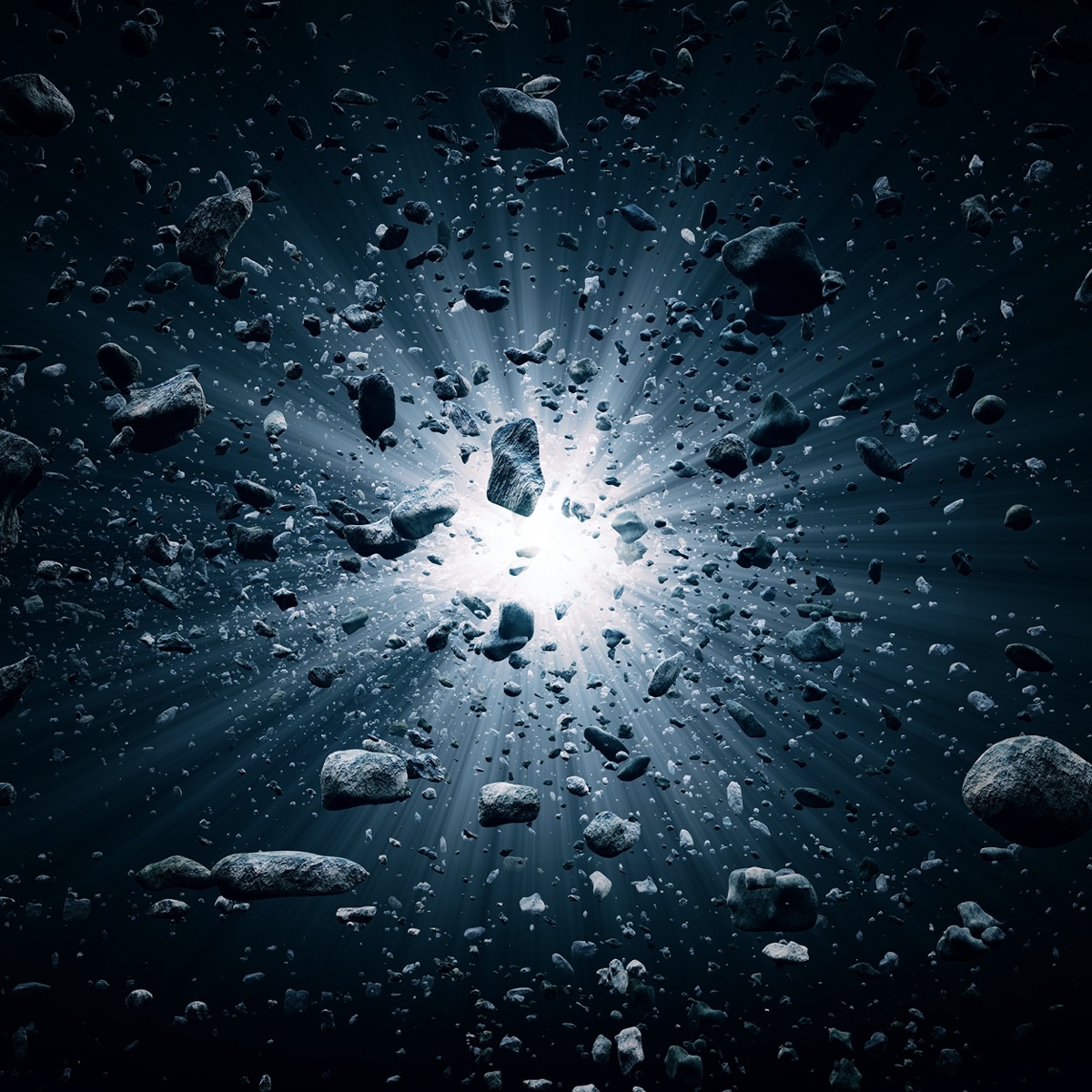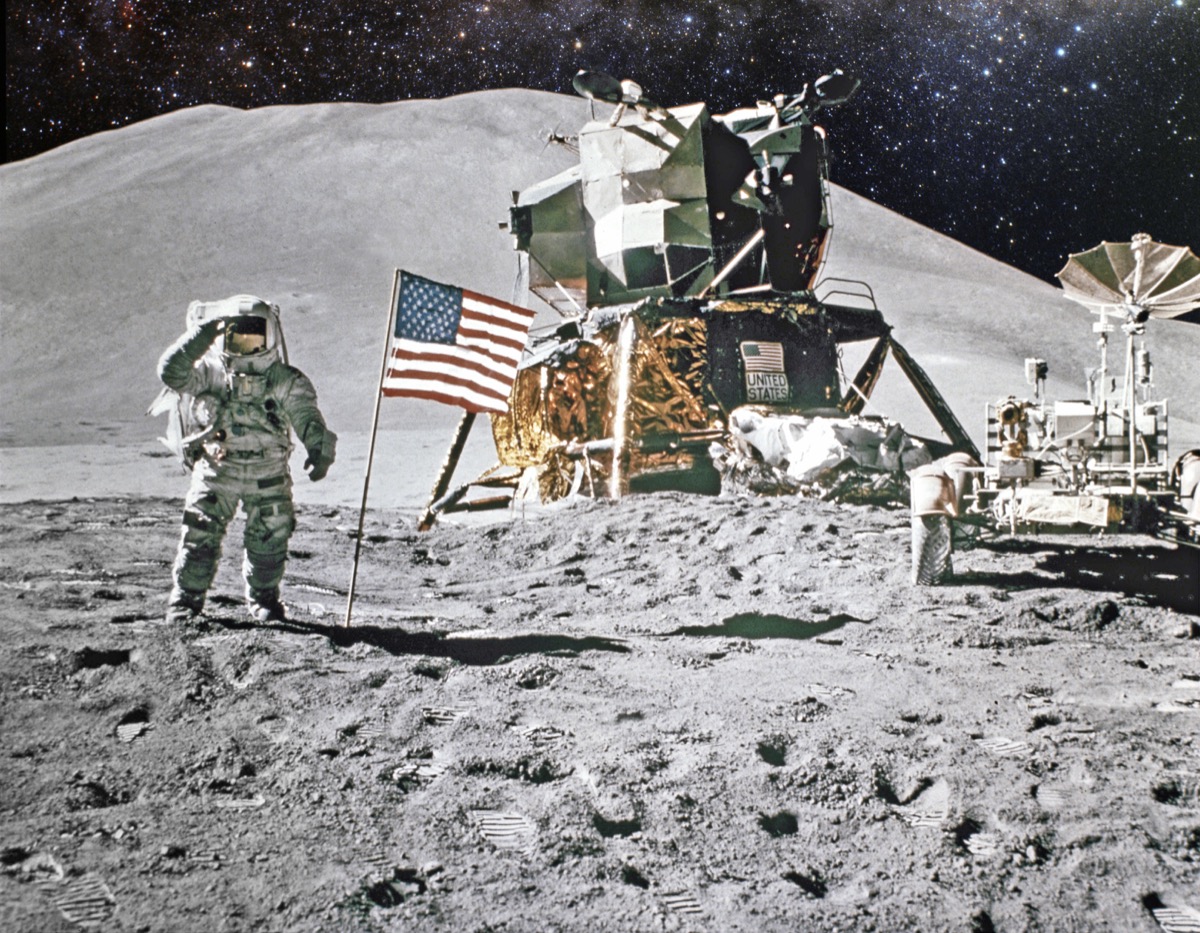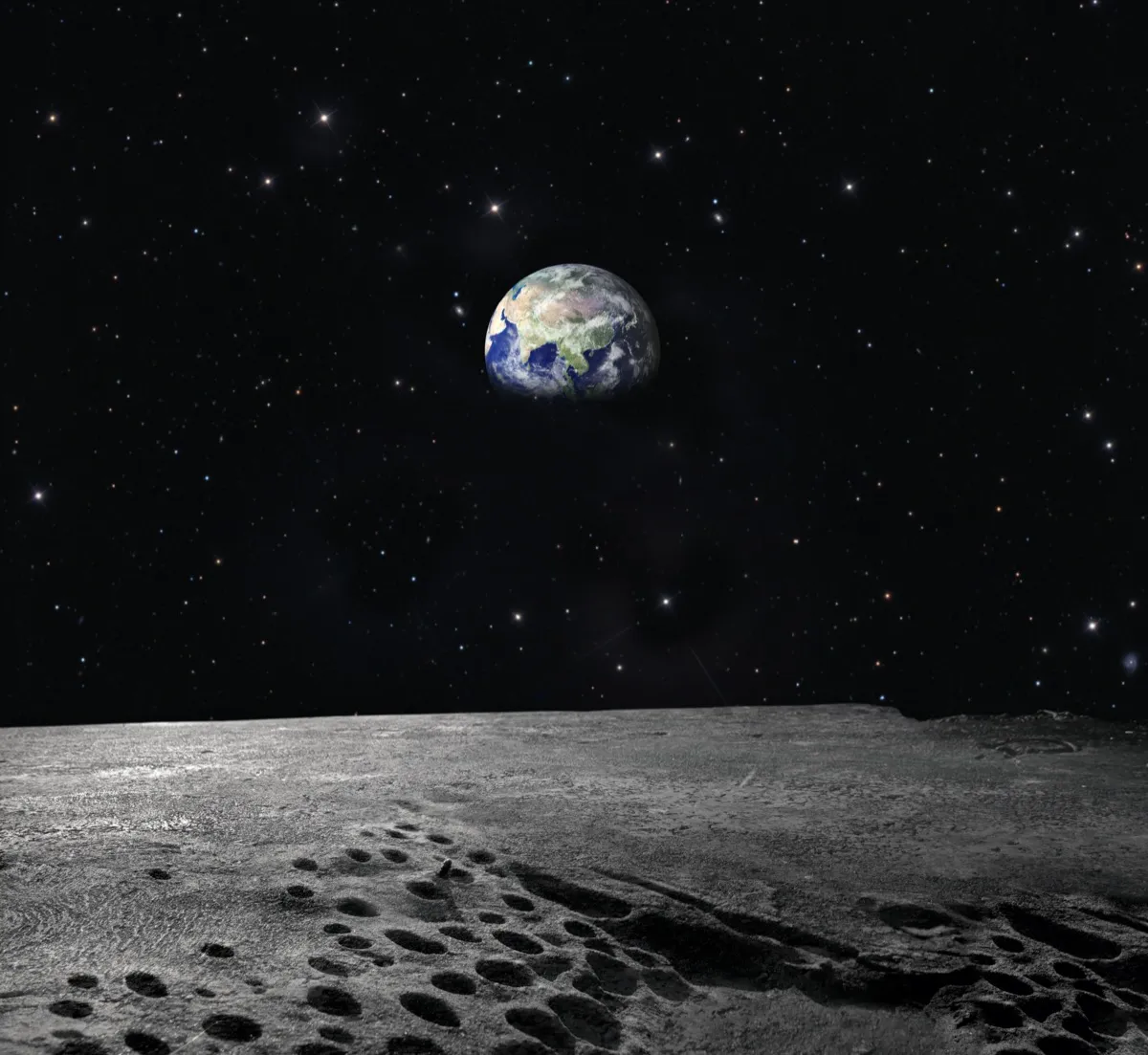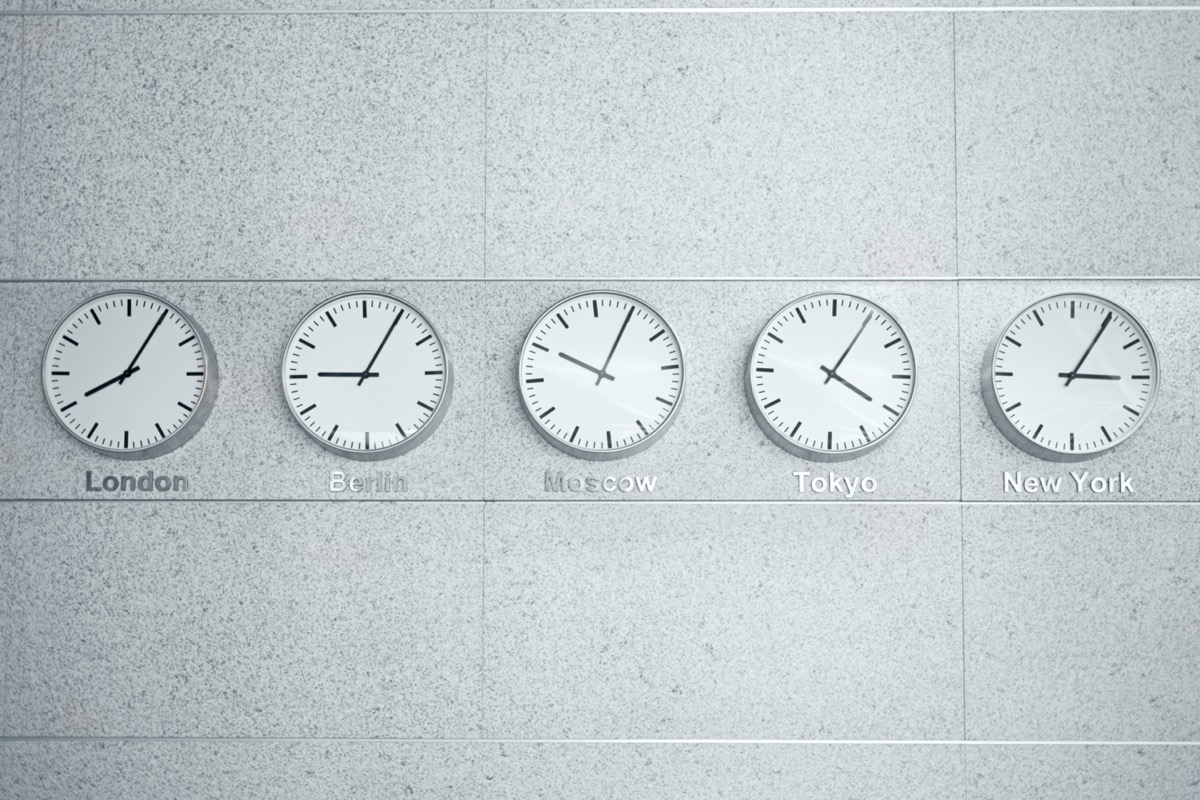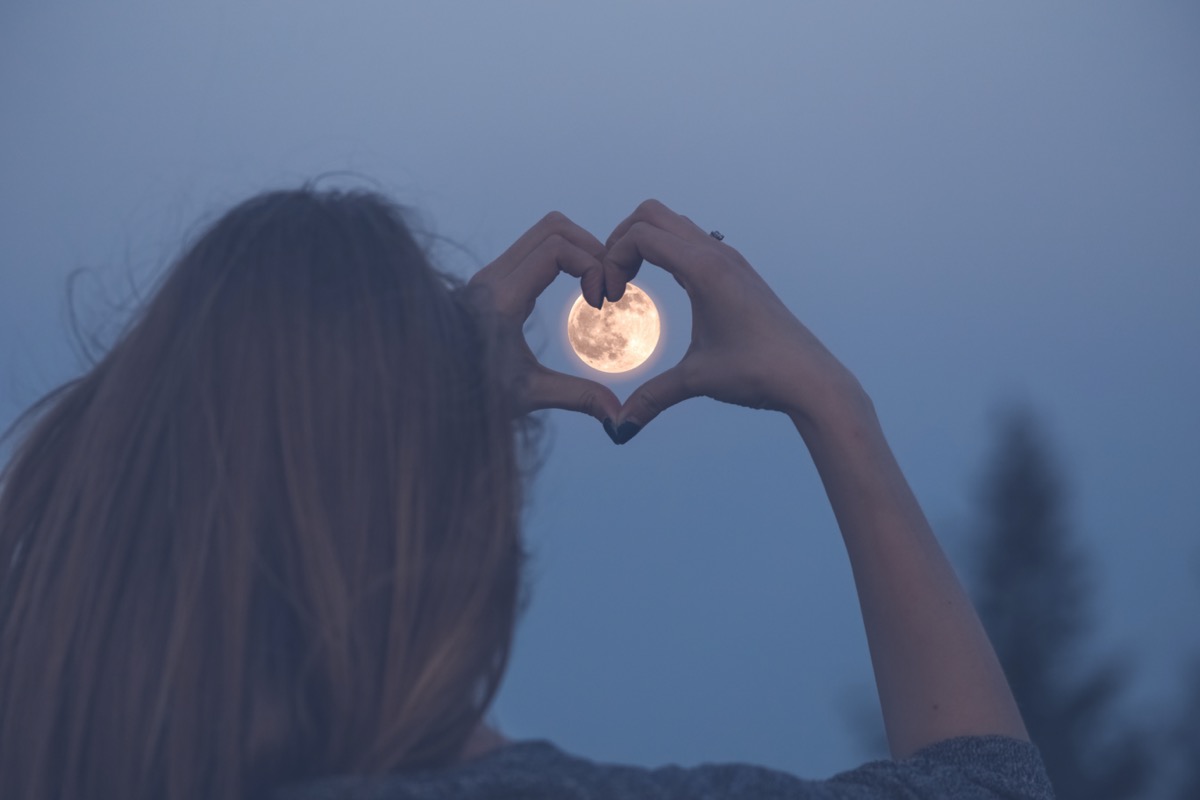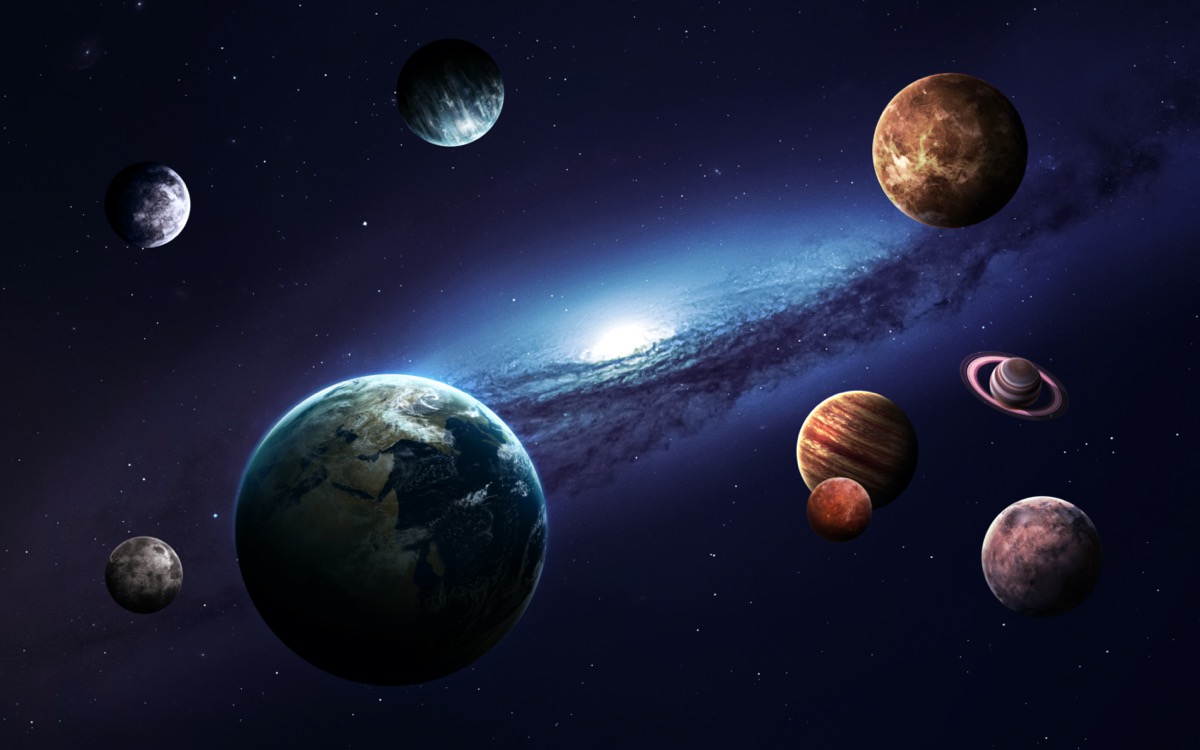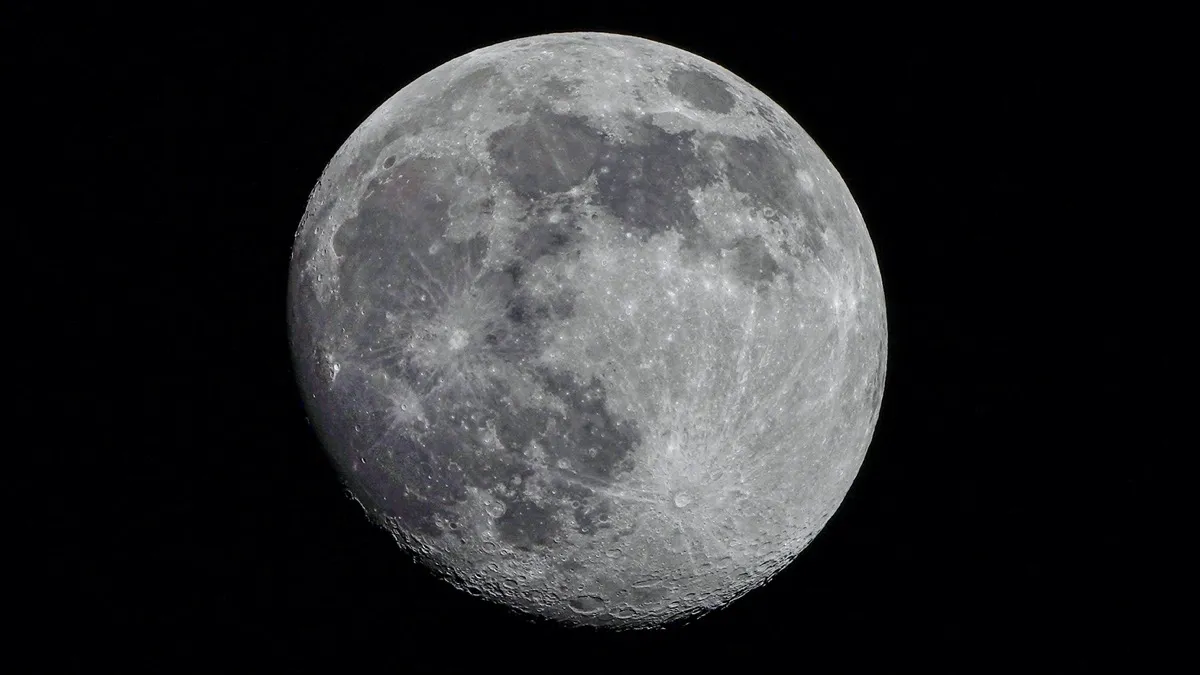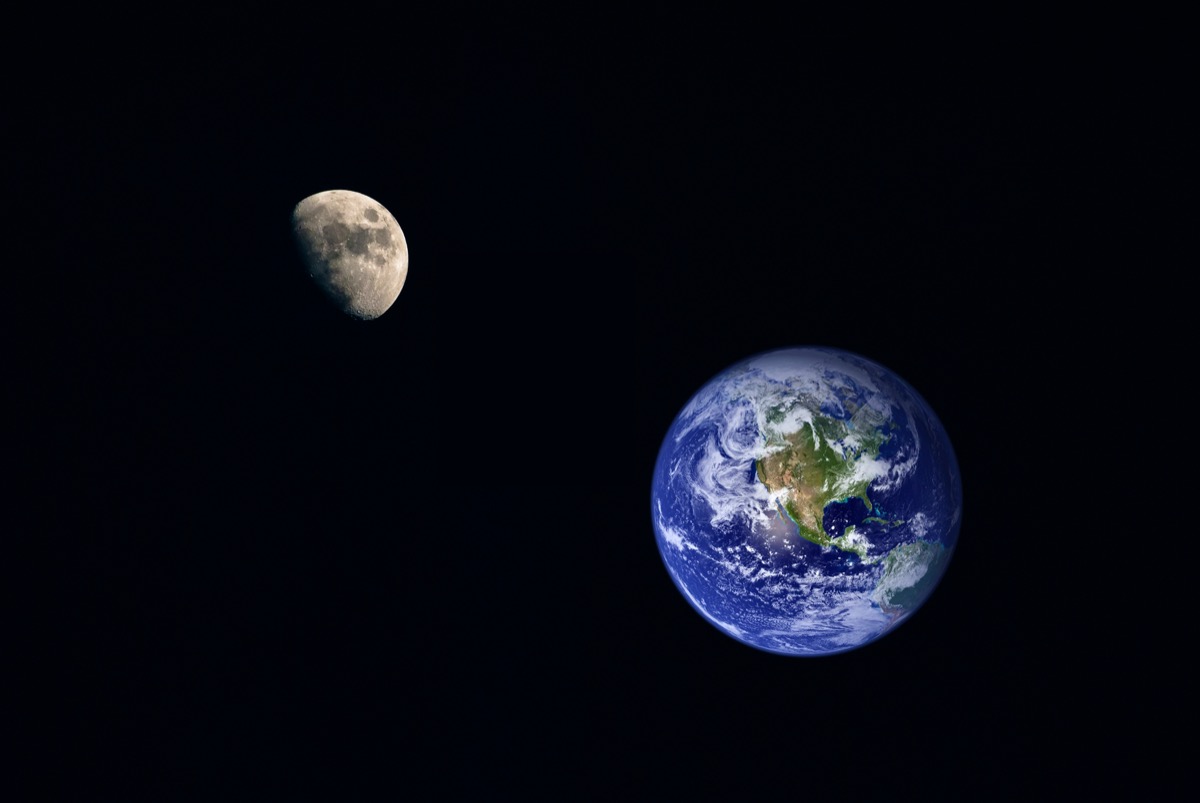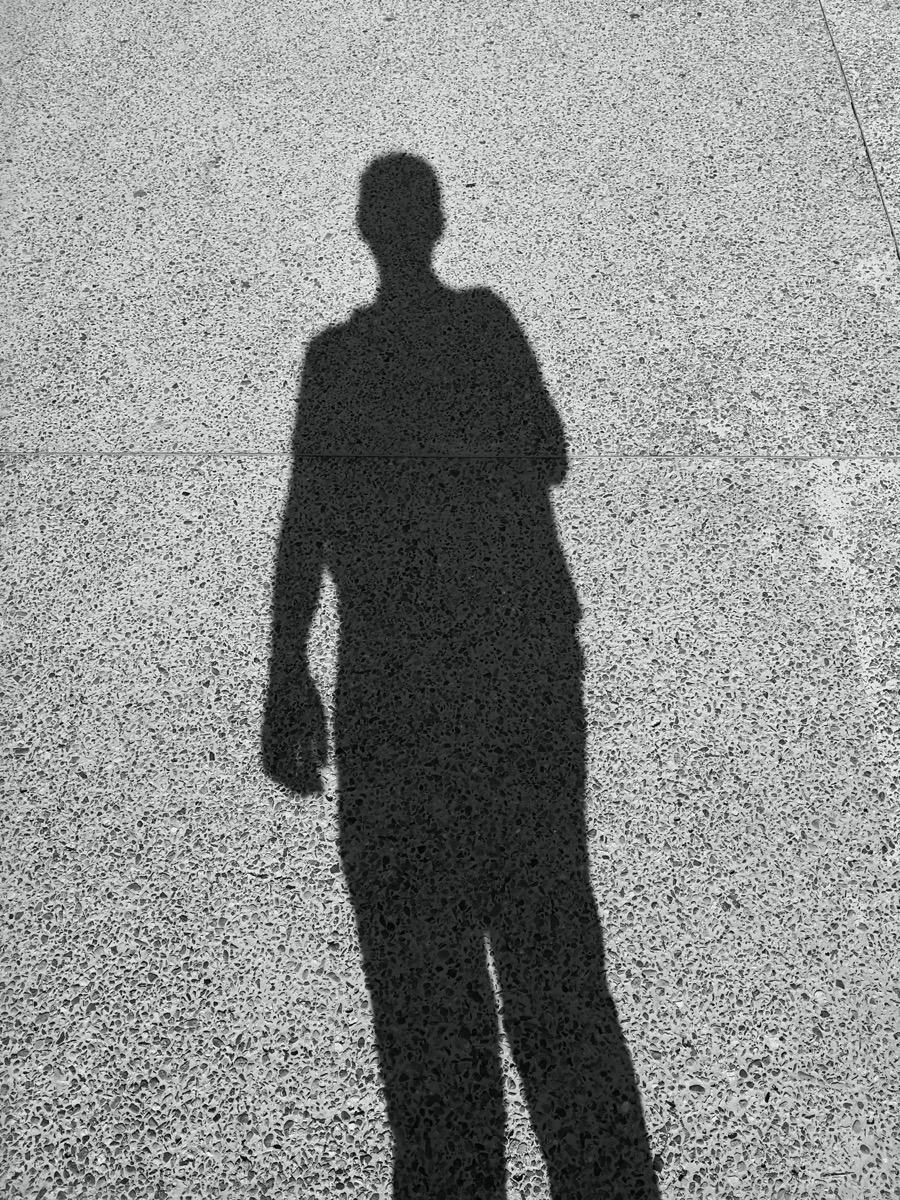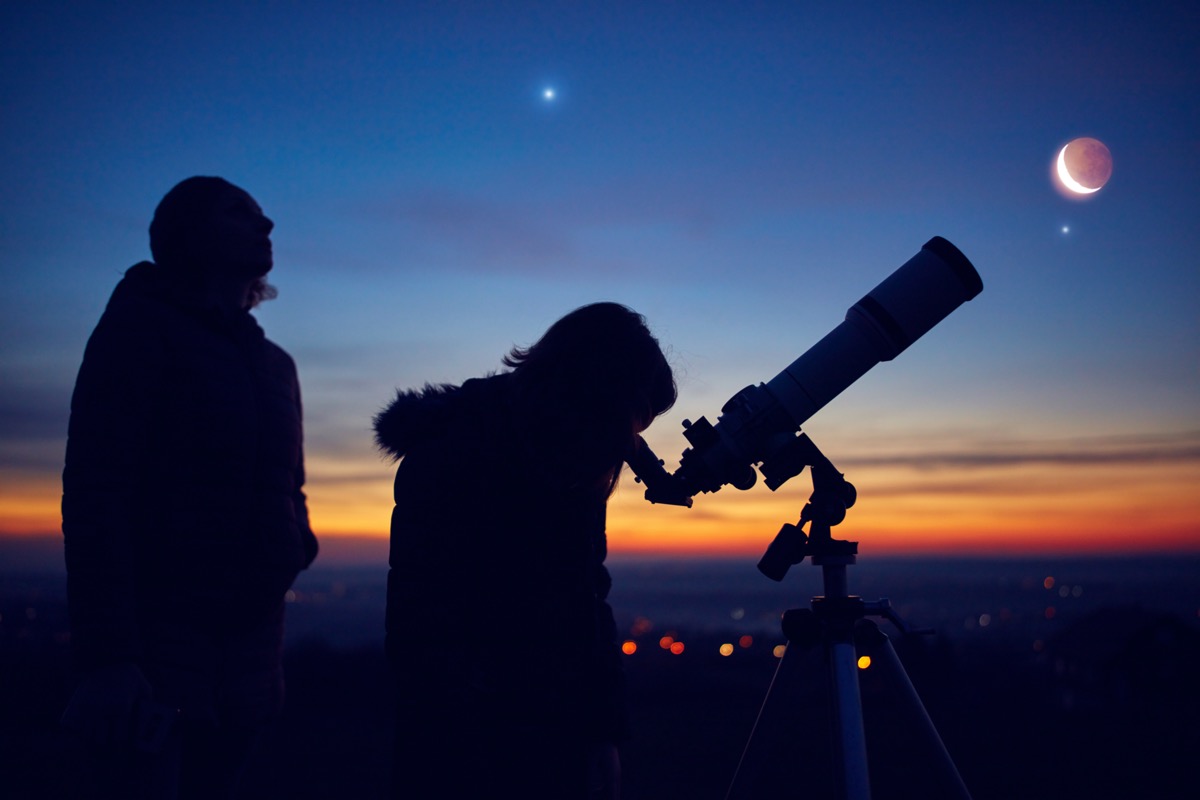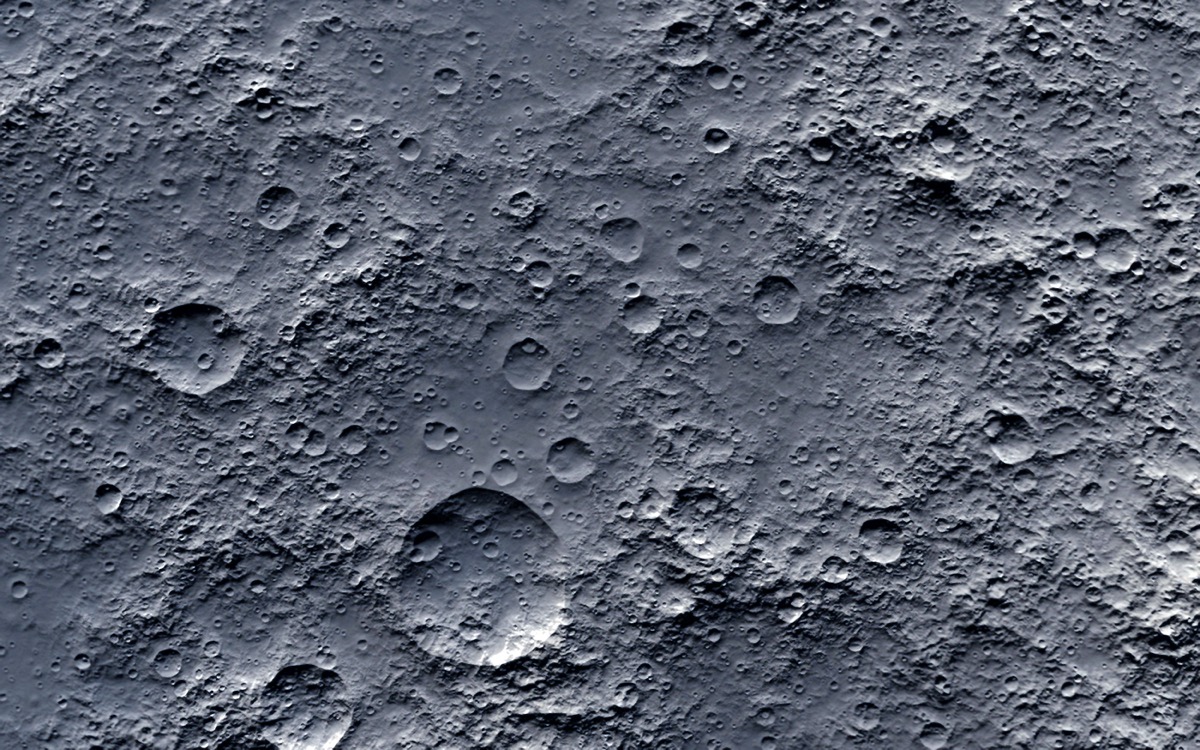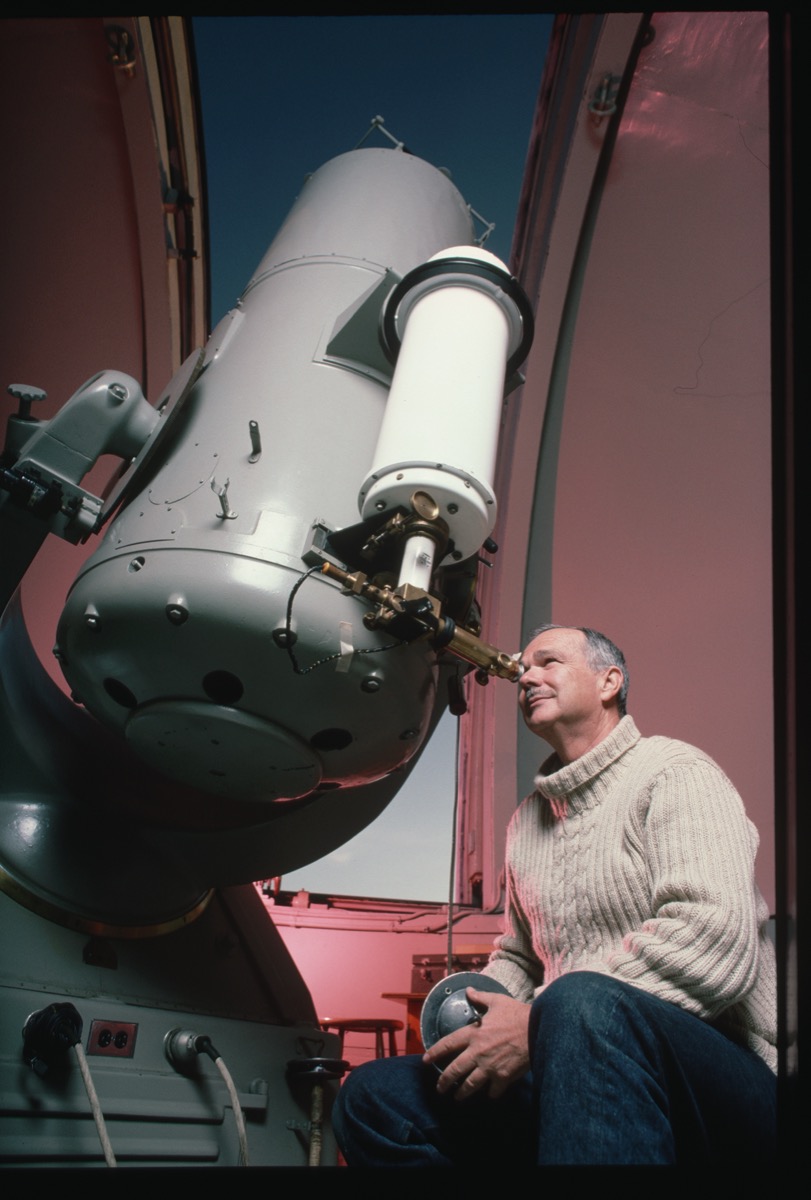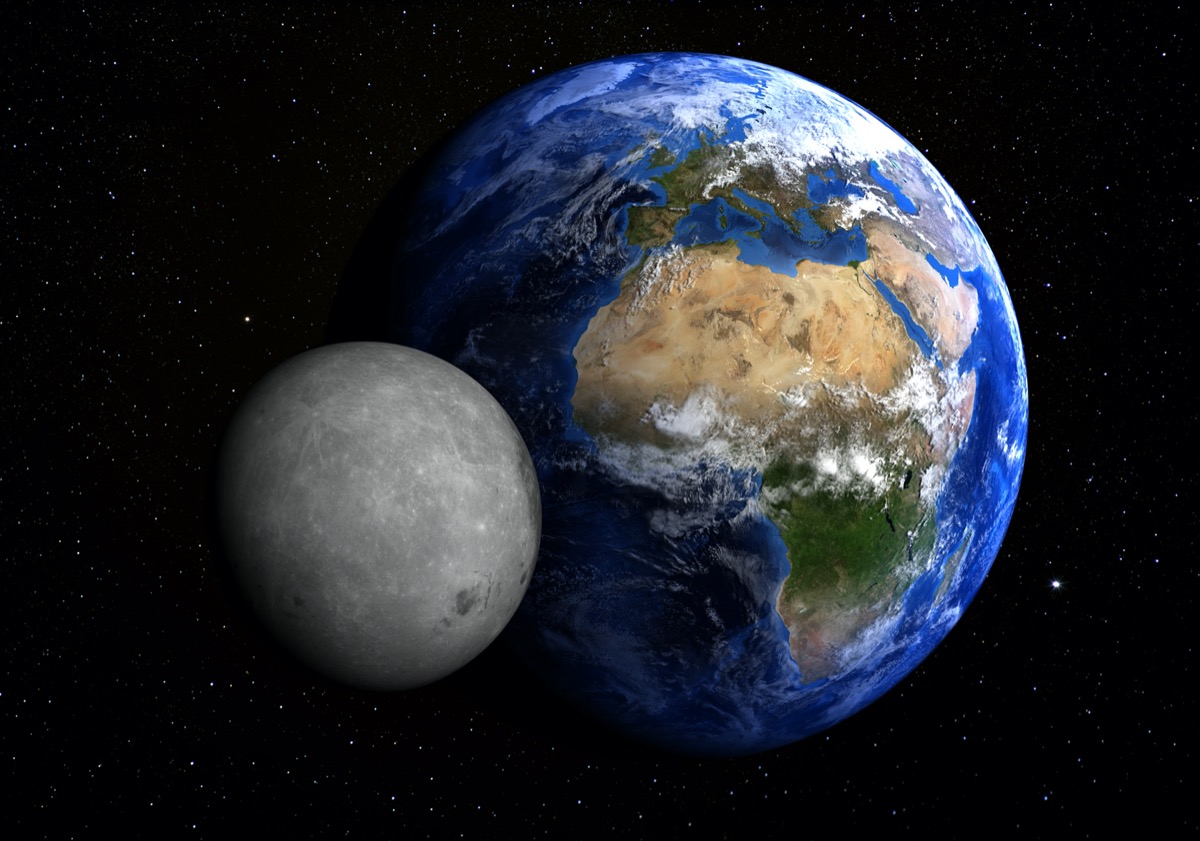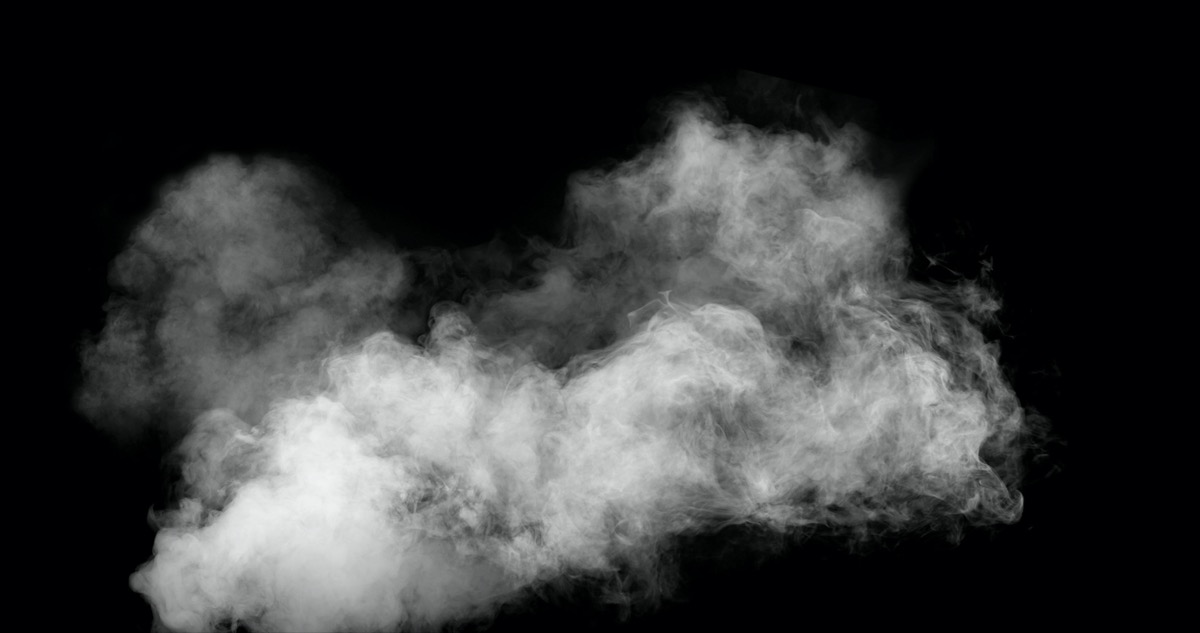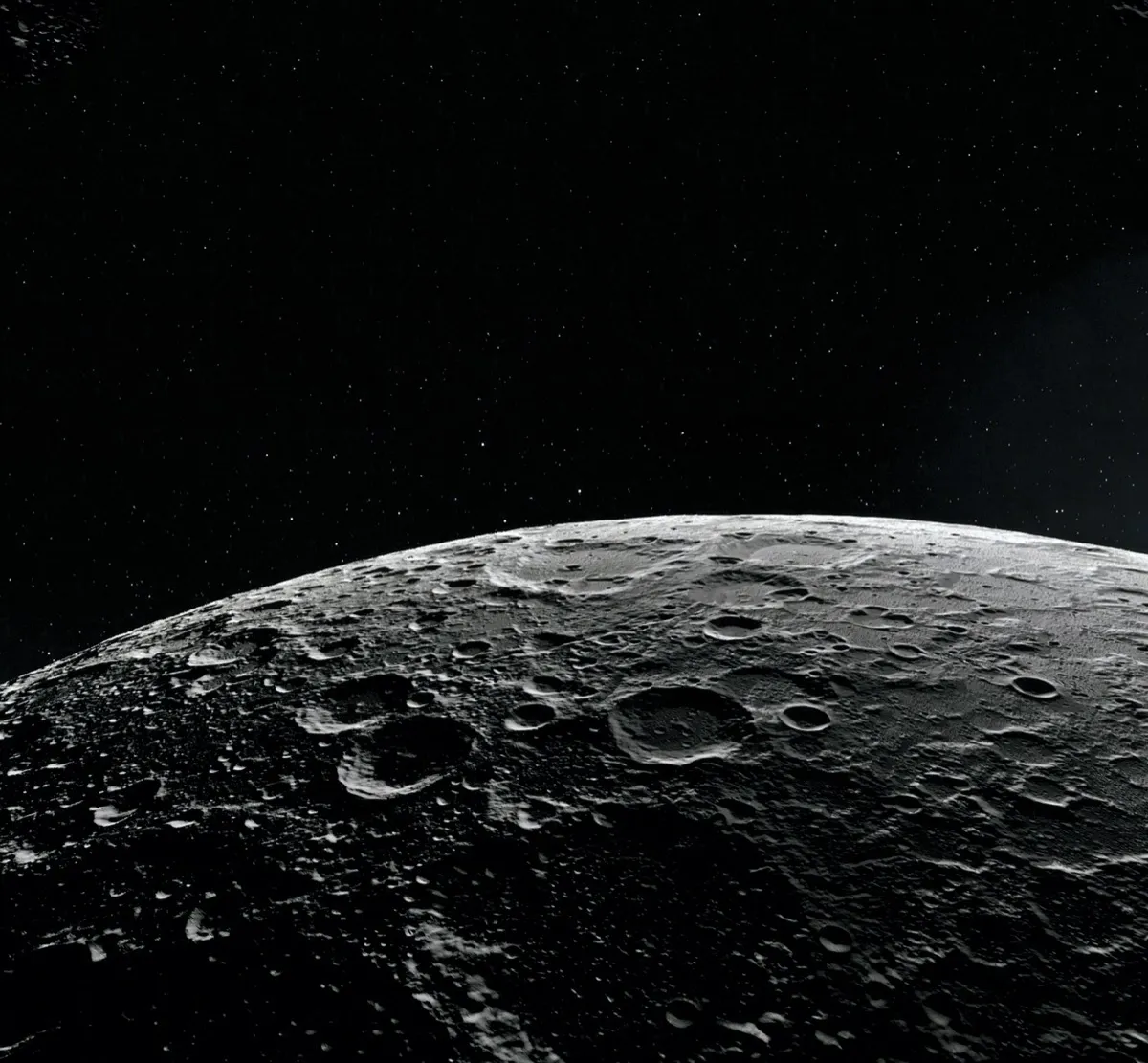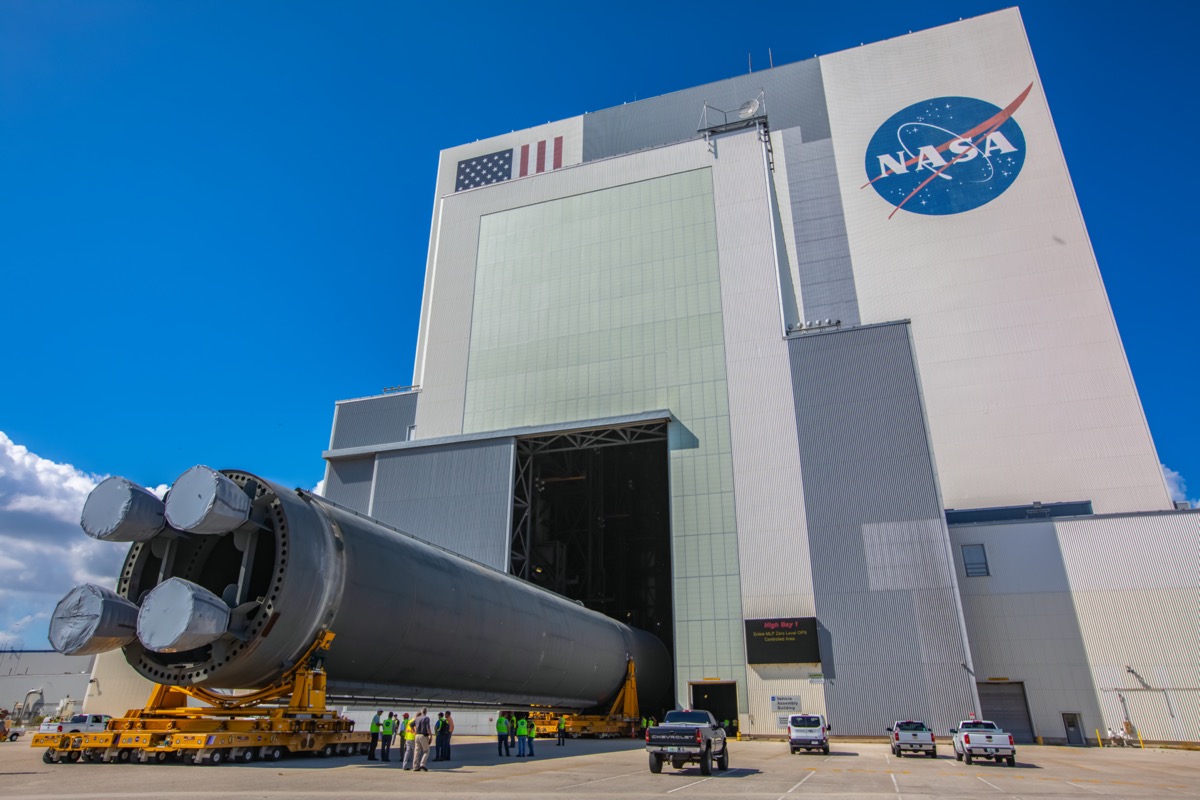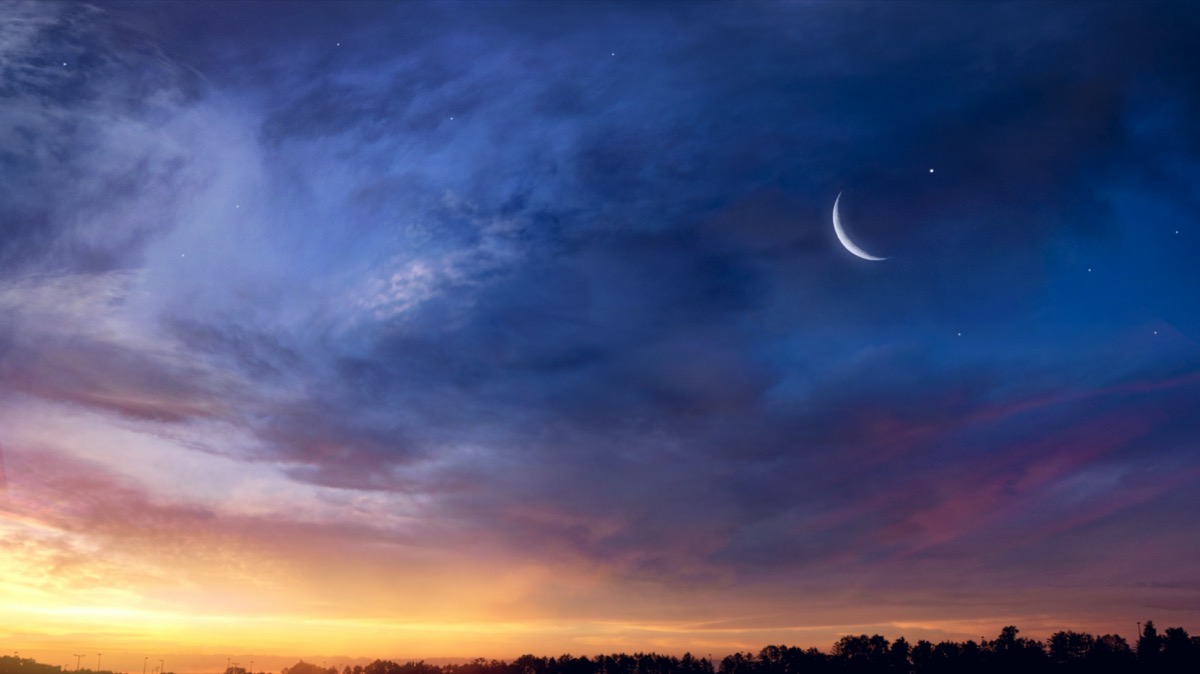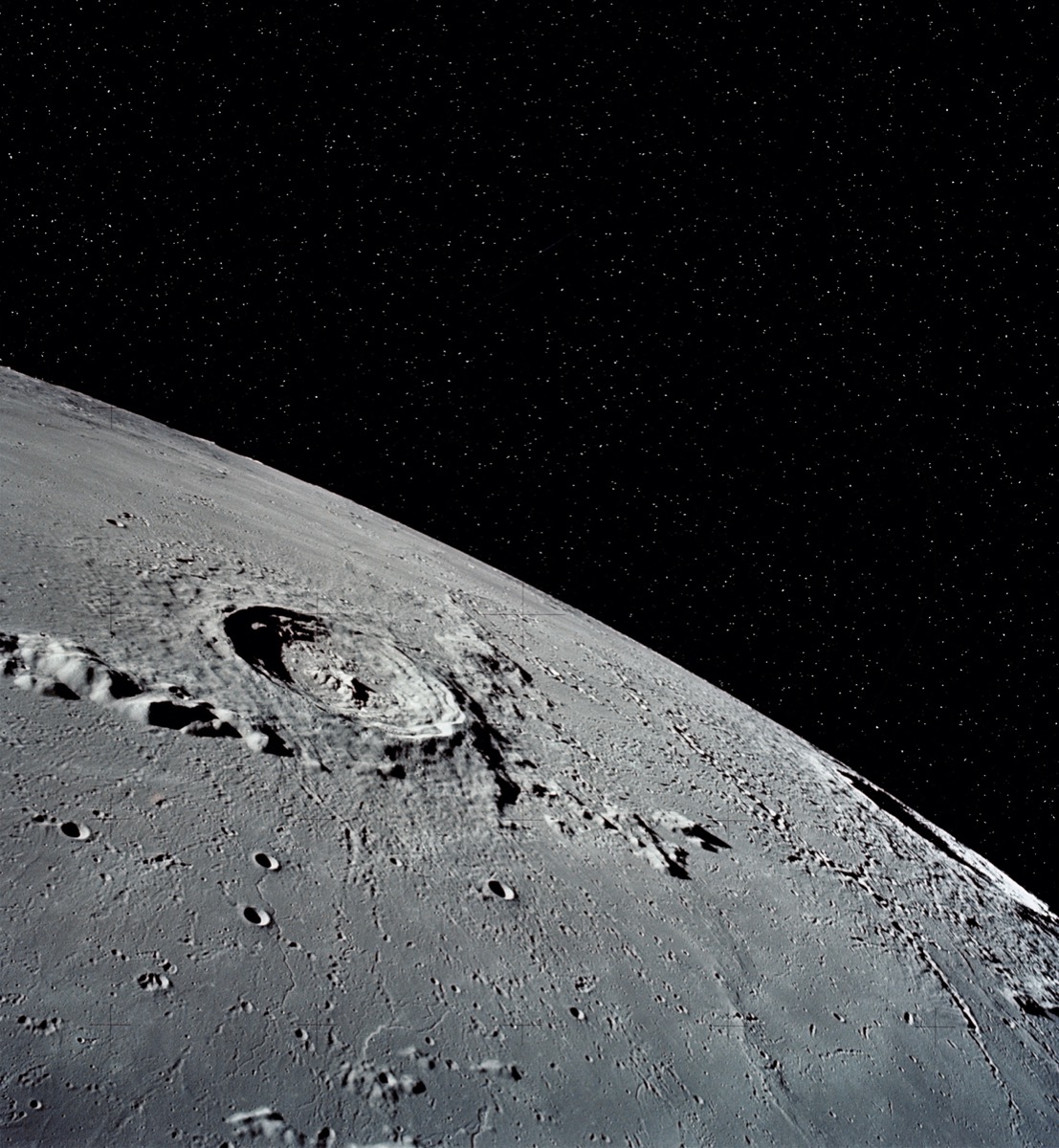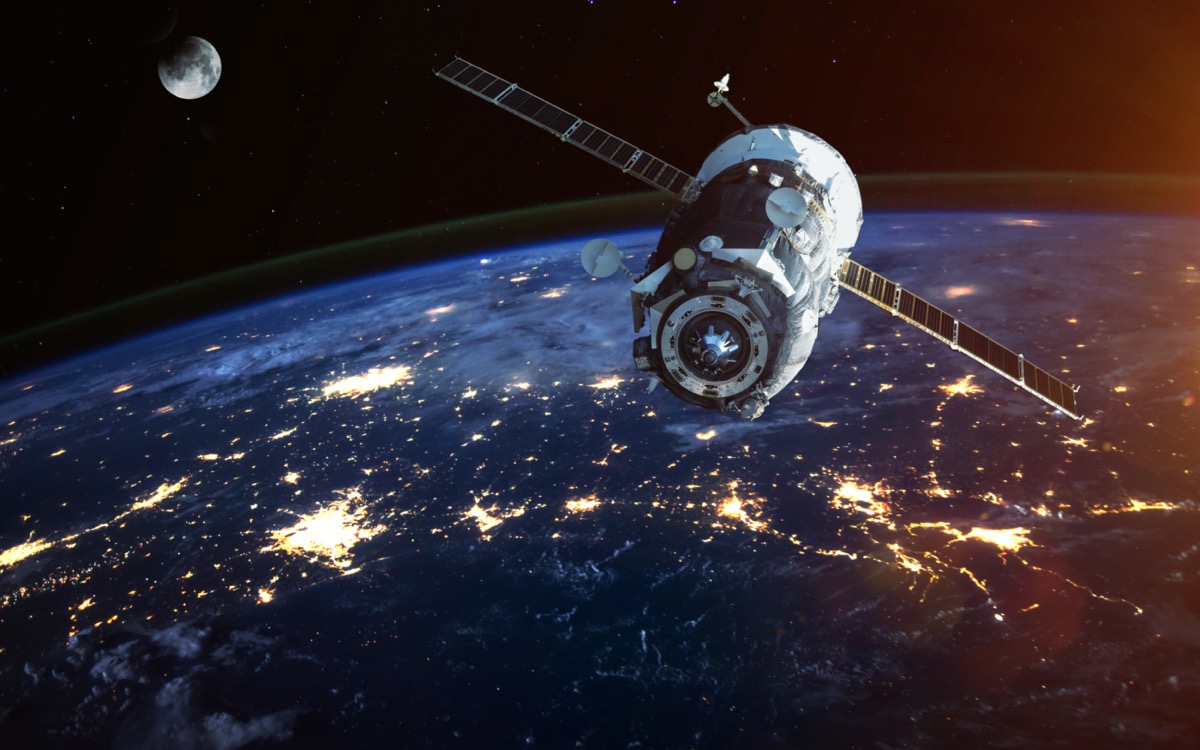RELATED: 175 Random Facts So Interesting You’ll Say, “OMG!” That number may seem quite staggering at first, however, the moon doesn’t produce its own light—it actually reflects the light of the sun. And not very well either. According to Sky and Telescope, “The brightness of the Moon depends on the exact angle between the Earth, Moon, and Sun…[and] the brightness of a Full Moon is usually quoted at a magnitude around -13, about 14 magnitudes or 400,000 times fainter than the Sun.” That means that the moon has a lot of work to do if it wants to be as flashy as our brightest star. In order to quash a potential game of calling dibs on the moon or any planets, the United Nations signed the Outer Space Treaty in 1967, two years before astronauts first landed on the moon. Some highlights of the treaty include a determination that “the exploration and use of outer space, including the moon and other celestial bodies, shall be carried out for the benefit and in the interests of all countries,” and a rule that parties to the treaty are “not to place in orbit around the earth any objects carrying nuclear weapons or any other kinds of weapons of mass destruction.” Well, that’s certainly a relief! If you thought that quakes were limited to just our planet, then hold onto your hats because it turns out that there’s a whole lotta shaking going on in space. During studies of the moon that were conducted between 1969 and 1972, Apollo astronauts installed seismometers around the locations they were exploring. According to NASA, the results showed that “moonquakes” ranged from very deep rumblings that took place about 700 km below the surface to “shallow moonquakes only 20 or 30 kilometers below the surface…that registered up to 5.5 on the Richter scale.” Billions of years ago, when Earth was just a spry young thing, it came into contact with a “Mars-sized planet” called Theia. The result of this collision was that “nearly all of Earth and Theia melted and reformed as one body, with a small part of the new mass spinning off to become the Moon as we know it,” according to the Natural History Museum. The process of the moon forming from the debris of the massive impact is called “rotational fission” and was verified by Apollo astronauts after samples of moon rock were found to have similar isotopes to Earth.ae0fcc31ae342fd3a1346ebb1f342fcb That beautiful sphere in the night sky is anything but perfectly round due to various factors, including impact craters and the gravity field which exists around the moon. UC Santa Cruz assistant professor of Earth and planetary sciences, Ian Garrick-Bethell, wrote in a paper, via UC Santa Cruz News, “If you imagine spinning a water balloon, it will start to flatten at the poles and bulge at the equator… On top of that, you have tides due to the gravitational pull of the Earth, and that creates sort of a lemon shape.” In the time since the Apollo 11 mission took place back in 1969, astronauts have abandoned plenty of items on the moon’s surface. Objects like tools, other equipment, food, human waste (yes, you read that right), and over 70 “spacecraft vehicles” are still up there, according to Britannica. Why was it left behind? Well, it would apparently cost too much to bring all that rubbish back to Earth. RELATED: The 60 Most Interesting World Facts You’ll Ever Hear. On a nice, clear night, a full moon seems almost close enough to touch. However, if you actually wanted to make it all the way from our planet to the lunar surface, you would have to travel between 225,623 and 252,088 miles. Struggling to conceptualize that? Well, consider the fact that NASA Science notes that when the moon is at its closest, it is the distance of 28 to 29 Earths away, and at its farthest, it is nearly 32 Earths away. You may live in the Eastern Time Zone or go by Pacific Standard Time, but if you’re looking to set your lunar watch, then you’ll need to set it to Universal Time (UT). According to Science Focus, Universal Time “is a modern form of Greenwich Mean Time” and stays the same no matter where you are in the big, wide expanse of space. That means “the UT time on the Moon is the same as the UT time on Earth.” As long as they don’t have Daylight Savings Time up there, then I think we can handle it. There is a full moon during every single month of the year, and each one has its own unique name. From January’s Wolf Moon to September’s Harvest Moon and December’s Cold Moon, the lunar phases have been used to keep track of each month over the course of centuries. National Geographic explains that “ancient cultures the world over have given these full moons names based on the behavior of the plants, animals, or weather during that month.” Now when you see a full moon in November, you can confidently point to the sky and wow your friends with the knowledge that you’re looking at the Beaver Moon. In 2019, China landed its Chang’e-4 spacecraft on the moon, but the astronauts didn’t just touch down in a random spot. Perhaps wondering what Pink Floyd has been fussing about, the spacecraft made its landing on the far side of the space-based body. History reported that it was “the first spacecraft in history to attempt or achieve a landing on this unexplored area, which is never visible from Earth.” While there, the Chinese astronauts studied the vast moon craters on the cold surface. Our moon may not be the largest one spinning around in space, but it’s not exactly the smallest either. Out of the 200 moons that are in our solar system, Earth’s moon ranks as the fifth largest, according to World Atlas. The biggest is Jupiter’s moon, Ganymede, which is almost one-and-a-half times more massive than ours. That must be one heck of a full moon! If you think that your hometown experiences extreme temperature shifts, try living on the moon. Unlike Earth, the moon has no atmosphere to help shield it from the radiation of the sun. This means that when the sun is hitting the surface of the moon, it’s baking the surface at a scorching 260° Fahrenheit. Beyond that, on the far side of the moon where the sun doesn’t shine, it can fall to a bone-chilling -387° Fahrenheit, according to The Planets. Have you ever gazed up at the moon and wondered about the contrasting light and dark spots that seem to cover the surface? What you’re looking at is remnants of ancient magma flow that caused the rock surface of the moon to appear darker. According to The Washington Post, these dark spots are called “Maria,” which is the Latin word for “sea.” So what you’re seeing are, in fact, former lunar seas, and not the face of the man on the moon. While it’s impossible for the average person to notice, the moon is indeed getting further from us. Science Focus explained that the lunar body is moving away from the Earth at a rate of 3.8 cm per year due to the effect of gravity. “Tides raised in the oceans cause drag and thus slow the Earth’s spin rate,” the outlet added while noting that the “resulting loss of angular momentum is compensated for by the Moon speeding up, and thus moving further away.” Hey, we get it, sometimes you just need some space. How can a shadow get darker? When on Earth, light is scattered and reflected through air molecules, which is why the sky looks blue and “allows objects not in direct sunlight to be still well-lit,” according to Universe Today. This effect is called “Rayleigh scattering” and doesn’t happen on the moon due to the fact that there is no air up there. That’s why shadows are darker on the moon’s surface, and spots that are hit with sunlight are even brighter. If that suspicious moon up there always seems like it has something to hide, that’s because it does. Apparently, the moon only shows us one of its sides because of something called “synchronous rotation.” As the Earth is rotating around the sun every year and spinning on its axis every day, the “moon orbits Earth once every 27.3 days and spins on its axis once every 27.3 days,” which Astronomy explains “means that although the moon is rotating, it always keeps one face toward us.” Honestly, though, there’s something to be said for always showing off your good side. The debate over thin crust and thick crust holds a little less significance when you’re on the moon. That’s because there’s something for everyone up there, and, no, we are not talking about pizza. Take a peek at NASA’s website to find a map displaying the seismic data of the “moon’s crustal thickness,” and you’ll notice that there’s a wide range of density due to impact craters and other phenomena. Some areas record up to 60 km of thickness while other areas record almost nothing. Air & Space noted that in some spots there is “a relatively thin crust, with mantle material being very close to the surface.” The name Eugene Shoemaker might not ring any bells, but this geologist was instrumental when it came to establishing planetary science. Among his many achievements include the fact that Shoemaker had a comet named after him and that he became the only human to have their remains buried on the moon. Indeed, back in 1998, some of Shoemaker’s remains were “launched in a memorial capsule aboard Lunar Prospector to the moon,” where they would go on to crash onto the surface, giving him a permanent residence on the lunar body, according to the University of Arizona. This gives a whole new meaning to the idea of the man on the moon. If you want to make an impact after your death and don’t want to settle for simply being buried six feet under, then you might want to check out this out-of-this-world send-off. Elysium Space boasts a team of space and funeral experts who combine “experience from major NASA space missions and deep-rooted funeral profession knowledge” in order to make your final resting place more than just a little memorable. A Lunar Memorial package starts at $9,950 and offers to send “a symbolic portion of remains to the surface of the Moon, helping to create the quintessential commemoration.” For more trivia sent directly to your inbox, sign up for our daily newsletter. We’ve already established the fact that the moon is a long way away from the Earth, but considering we’re still able to see the moon so vividly, you may wonder how big it really is. Well, NASA explains that an equatorial circumference of 10,917 km means that the moon is around 27% of the size of the Earth. To put it in other words, if Earth were a tennis ball, then the moon would be a golf ball. According to Space, that’s “a much larger ratio (1:4) than any other planets and their moons.” You can’t see it with your own eyes but the moon is clouded with space dust. Findings from LADEE (Lunar Atmosphere and Dust Environment Explorer) show that the “moon is engulfed in a permanent, but lopsided, dust cloud.” According to Mihaly Horanyi, CU-Boulder physics professor, via NASA, “The cloud is primarily made up of tiny dust grains kicked up from the moon’s surface by the impact of high-speed, interplanetary dust particles.” The moon is covered with impact craters that add to its recognizable Swiss cheese-like charm. But the largest of the lot is the South Pole-Aitken crater, which spans a whopping 1,550 miles. This enormous basin stretches about a quarter of the length of the moon, and NASA explains that it may have formed from a “cataclysmic event that occurred 3.9 billion years ago.” The latest research has also discovered a metallic anomaly the size of Hawaii within the depths of the basin. If that isn’t the beginning of a potentially terrifying sci-fi film, then we don’t know what is. As research focusing on the Earth’s moon continues, NASA is planning to set up a home away from home during the Artemis III mission, which is scheduled to make its way to the lunar surface in 2024. The Artemis Base Camp will make it possible for astronauts to stay on the surface for an extended period of time, however, choosing the perfect location will be paramount to the success of the base. According to NASA, the “site must bask in near-continuous sunlight to power the base and moderate extreme temperature swings,” while also “offer[ing] easy access to areas of complete darkness that hold water ice.” So just like real estate, it’s all about location, location, location. Ever wonder why and how pink and red moons got their names as well as their distinctive colors? It turns out that the lunar surface isn’t some kind of high-tech LED lighting system, but instead gets its delightful hues when the sun’s light passes through the Earth’s atmosphere and reflects on the moon. During a rare blue moon, the hue is caused by “ashes of a volcanic eruption or even a forest fire” down on Earth, according to Online Star Register. And during a Harvest moon, while farmers are working on their crops, dust particles are sent into the atmosphere that, with the help of the sun’s rays, give the low-hanging moon its dramatic orange glow. Forget about Moon Pies, although they are delicious—how about being able to grow your very own Moon Tree? During the Apollo 14 mission in 1971, Command Module Pilot Stuart Roosa headed scientific experiments while in the moon’s orbit. He took with him “a canister of approximately 400-500 loblolly pine, sweetgum, redwood, Douglas fir, and sycamore tree seeds,” according to NASA. And “upon return [to the Earth], the seeds were germinated and grew into ‘Moon Trees.’” These super special trees can still be found growing across the United States. Now you can blame the moon for affecting your nightly slumber, instead of that pot of late-night coffee. A study conducted by scientists from Switzerland’s Basel University and published by Current Biology in 2013 aimed to find out whether volunteers had a difficult time resting during a full moon. The result of the study suggest that “lunar influences” caused subjects to take longer to fall asleep, sleep less, and spend fewer moments in a state of deep sleep. Apparently, it wasn’t due to the brightness of a full moon, rather it was “the lunar cycle [that] seems to influence human sleep, even when one does not see the moon and is not aware of the actual moon phase,” Christian Cajochen explained, according to the BBC. Before you tell the love of your life that you would move heaven and Earth for them, maybe offer instead to shift the moon instead. According to Space, the mass of our moon is “7.35 x 1022 kg, about 1.2 percent of Earth’s mass,” which means that the planet that we’re living on weighs 81 times more than the lunar body above us. Next to Jupiter’s moon, it’s the “second densest moon in the solar system.” Not that it’s a competition or anything. The names of some areas on the moon tend to pay homage to past scientists and explorers. Others sound almost whimsical, like the Sea of Tranquility and Sea of Serenity. If you happen to discover a new crater on the moon and want to give it a title, you’ll need to follow 14 rules from the International Astronomical Union (IAU). These guidelines prevent cheeky astronomers from naming the next large crater something unfortunate. Although the moon is not responsible for increasing the power of our WiFi or adding more TV channels to our dish, it is just one of many satellites that are in Earth’s atmosphere. “A satellite is a moon, planet, or machine that orbits a planet or star,” according to NASA, and while the moon is Earth’s only natural satellite, it’s circling us with over 3,300 artificial satellites, including Sputnik, which was launched back in 1957. The moon was once a hotbed of volcanic activity. As molten lava from the volcanoes hardened billions of years ago on the lunar surface, it helped to create unique craters. In 2014, NASA reported that a team from Arizona State University discovered “irregular patches” on the moon that originated from volcanic eruptions as recently as 50 million years ago. Thankfully, the moon’s volcanoes have been dormant since then, so we don’t have to worry about eruptions anytime soon. RELATED: 125 Facts That Will Make You Feel Instantly Smarter.
